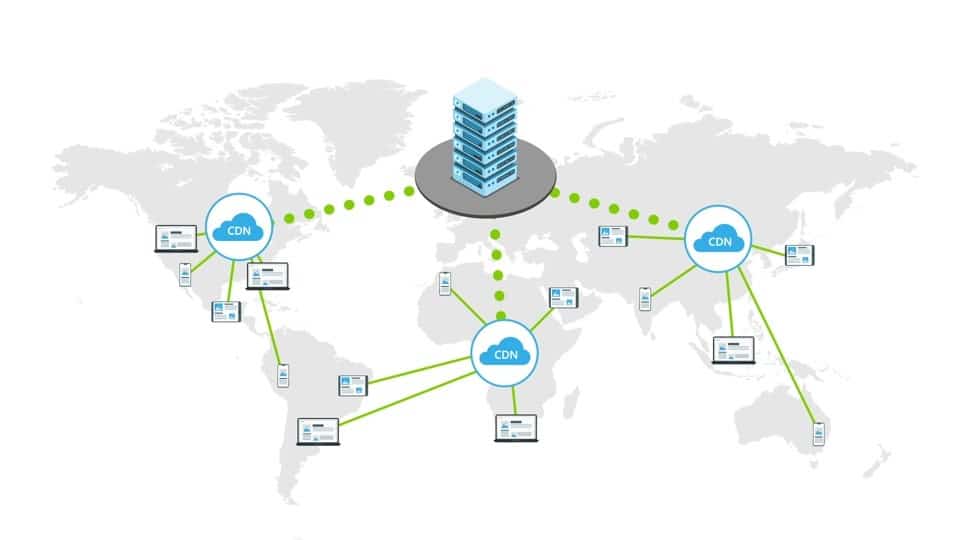We all engage with web content so extensively that we often become blind to it. It’s easy to forget about much of the technology running everything behind the scenes.
However, if you want to create digital content and leverage it to your own benefit, some technical know-how can help you make better plans and provide a better user experience.
There are plenty of topics to cover, but today, you can learn about a network system designed specifically for content delivery and how it improves the end-user experience.
What Is a Content Delivery Network (CDN), and How Does It Work?
A CDN constitutes a group of servers specifically designed to cache and deliver content across the internet. By working on the edge of networking, such servers bring content data closer to end users and help load web content faster. They work with HTML, JavaScript, style sheets, images, and videos.
It’s worth noting that CDNs utilize geographic distribution, meaning the various servers are not physically close to each other. This distribution helps reduce latency and speed up network responses for end users worldwide.
While many architectures and designs are possible, most CDNs use Points of Presence (PoP) to synchronize their distributed servers. Applied to regional data centers, this design often provides the most cost-effective solution.
Another point of interest is that CDNs do not replace traditional web servers. Instead, they support web servers by offloading a lot of raw processing load. Ultimately, the web server still plays a pivotal role in bringing content to end users.
How does a CDN work?
Speaking a little more technically, CDNs cache content at the network edge. This improves site performance by reducing storage and processing burdens on web servers. It also allows web servers to distribute more content per second, as they are bolstered by the raw server resources in the CDN.
Key Benefits of Using a Content Delivery Network
Now that you have a rough idea of how a CDN works, how does it help specifically? What can you expect to gain when investing in a CDN for your web content?
Faster load times
Perhaps most notably, CDNs improve load times. This is the general advantage behind content caching. It’s similar to how your personal device can cache website content to reload a site more quickly next time.
Splitting the load reduces strain on the web server so it doesn’t get bogged down as easily with multiple requests.
Reduced bandwidth
In the same way a CDN can lower load times, it can also reduce bandwidth consumption. Since less content must come directly from the web server, the server won’t use as much bandwidth. While that can help with uptime and stability, it can also lower costs. If a web server consistently uses less bandwidth, you might be able to pay for a lower service tier.
Increased content availability
As the CDN allows you to spread content across the network, you can host more types of content without overwhelming your web server. Additionally, you have better server capacity to host a broader range of content. On top of that, the content is more regionally available as the CDN distributes data to regional centers.
Content redundancy
Content availability pairs nicely with redundancy too and it can be stored across multiple CDN servers. Other servers can pick up the slack if one server goes down or experiences issues.
Website security
Lastly, CDNs improve website security through decentralization. Any piece of your content is harder to attack as it isn’t all stored in one place.
More notably, using a CDN dramatically reduces the risk of DDoS attacks by spreading download requests across the CDN. The capacity is so much greater than a typical web server that standard DDoS attacks won’t crash the CDN.
Common Use Cases for Content Delivery Networks
Understanding the essential functions and primary benefits of a CDN helps you paint a picture, but there’s still plenty more to cover. What does CDN usage look like in the real world?
There are countless examples and applications, but you can look at a handful of specific scenarios to better understand how to leverage a CDN.
Streaming, software distribution, e-commerce, and high-traffic uses all benefit from CDN deployment.
Streaming and video
Video content often benefits the most from CDNs. Video easily eats up the most storage and bandwidth in web applications. As your CDN expands your total storage and delivery capabilities, it increases your ability to support video and video streaming.
E-commerce
E-commerce can improve conversion rates with a CDN. A CDN improves responsiveness, which lowers the number of abandoned carts. When fewer carts get abandoned, conversion rates and the whole bottom line improve.
That’s to say nothing about how CDNs can bolster your content marketing strategy with improved content delivery.
Software distribution and gaming
Software distribution and gaming often require hefty downloads and intense digital communication. CDNs distribute much of this communication across their networks, stabilizing the process and allowing for increased ambition in software and gaming offerings.
High traffic
Major corporate websites see a lot of traffic. Think about Amazon as an example. How many requests per second do Amazon web servers receive? Amazon doesn’t publish that information, but some suspect the number is in the hundreds of millions.
It’s easy to see how a distributed content network could help manage so many requests.
Digital events can also bring heavy traffic. Major announcements, ticket sales for events, and similar sources of massive traffic and requests fall nicely into this category.
Like any other application, CDNs manage the load to make everything more stable, reliable, and speedy.
How CDNs Differ from DNS and Traditional Hosting
CDNs typically use dynamic request routing. This means addresses change constantly, and the CDN doesn’t need to know the physical locations of all users involved. That’s mainly because CDN sits on the edge but does not finalize delivery to users. That is largely offloaded onto DNS.
DNS basics
DNS uses a distributed directory of addresses. Essentially, the DNS creates a name for every static IP on its list, which allows it to connect web servers and end users directly.
Comparatively, a CDN only has to connect the most relevant CDN server to a regional data distribution center. It doesn’t need as many addresses or a direct connection mechanism.
Integrating the two
You benefit the most when you integrate the two. DNS handles user-specific data requests and direct communication between users and web servers. CDNs offload as much information transfer as they can through dynamic request routing.
This provides the best of both worlds, with users ultimately getting everything they want through a faster, more secure, and more reliable integrated system.
Choosing the Right CDN for Your Website or Application
With all that covered, how do you choose the right CDN? What should you look for? Are there industry leaders that make for a good starting point? You will find these answers and more in this section.
Features
Features make up the natural starting point when shopping for CDN options. Your top features include speed, security, and scalability. If your CDN cannot match your needs and expectations with all three of these, it’s not a viable candidate.
Once the essentials are satisfied, you can compare additional features that might suit specific use cases you have in mind.
Popularity
Even when you compare features, you will find plenty of viable CDN candidates. Here are some of the most popular:
- Cloudflare
- Akamai
- CloudFront
When you compare these, you can see varying levels of global reach, different price points, varied scalability solutions, and distinct capacities at each service tier. That said, these are global leaders in each of these categories.
Best Practices
There are many best practices for implementing and configuring your CDN, but a few will help you get started.
First, focus on caching static content. That’s where you get the most benefit from your CDN.
At the same time, avoid caching user-specific content. Caching that in the CDN often proves resource-inefficient.
Lastly, you can optimize the cache by setting expirations for any time-sensitive content.
Wrap Up
CDNs can help you gain better control and productivity over web content and hosting, but you still need the content in the first place. For that, WriterAccess can help.
You can try a 14-day free trial to get a feel for how WriterAccess can help you scale and improve your content production.




![[ROCK NA] [EBOOK SEO] Complete Guide](https://rockcontent.com/wp-content/uploads/2024/06/banner_Search-Engine-Optimization.png)





